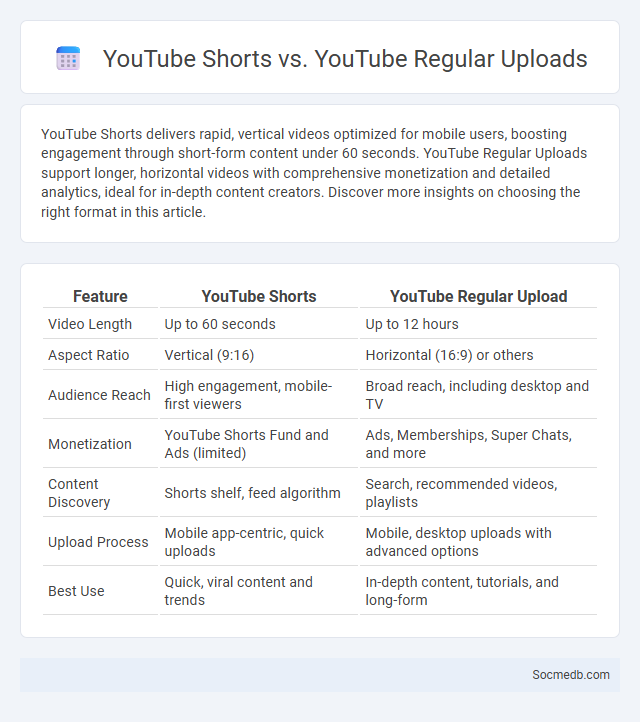
Photo illustration: YouTube Shorts vs YouTube Regular Upload
YouTube Shorts delivers rapid, vertical videos optimized for mobile users, boosting engagement through short-form content under 60 seconds. YouTube Regular Uploads support longer, horizontal videos with comprehensive monetization and detailed analytics, ideal for in-depth content creators. Discover more insights on choosing the right format in this article.
Table of Comparison
| Feature | YouTube Shorts | YouTube Regular Upload |
|---|---|---|
| Video Length | Up to 60 seconds | Up to 12 hours |
| Aspect Ratio | Vertical (9:16) | Horizontal (16:9) or others |
| Audience Reach | High engagement, mobile-first viewers | Broad reach, including desktop and TV |
| Monetization | YouTube Shorts Fund and Ads (limited) | Ads, Memberships, Super Chats, and more |
| Content Discovery | Shorts shelf, feed algorithm | Search, recommended videos, playlists |
| Upload Process | Mobile app-centric, quick uploads | Mobile, desktop uploads with advanced options |
| Best Use | Quick, viral content and trends | In-depth content, tutorials, and long-form |
Overview of YouTube Content Formats
YouTube offers diverse content formats, including vlogs, tutorials, live streams, and short-form videos tailored for quick engagement. Each format serves distinct purposes, optimizing audience reach and interaction on the platform. Understanding these options helps you create content that maximizes viewership and retention effectively.
What Are YouTube Shorts?
YouTube Shorts are short-form vertical videos, typically lasting up to 60 seconds, designed for mobile viewing and quick consumption. This feature allows creators to reach a broader audience by leveraging engaging, bite-sized content optimized for discovery through the Shorts shelf on the YouTube app. YouTube Shorts combines music, speed controls, and a multi-segment camera to enhance creativity and maximize viewer engagement.
Features of Regular YouTube Uploads
Regular YouTube uploads enhance your channel's visibility by boosting algorithmic favor, increasing subscriber engagement, and maintaining audience interest through consistent content delivery. Features include scheduled publishing, playlist organization for thematic coherence, and analytics-driven improvements that tailor content to viewer preferences. You benefit from higher watch time and improved search rankings, directly impacting your channel growth and community building.
Key Differences: Shorts vs Regular Uploads
Shorts on social media are vertical videos typically under 60 seconds designed to capture quick engagement and increase viral potential, often favored by platforms like YouTube Shorts and Instagram Reels. Regular uploads allow longer-form content with more detailed storytelling, enabling creators to build deeper connections through higher-quality production and comprehensive narratives. While Shorts boost visibility through rapid consumption and frequent posting, regular uploads contribute to sustained viewer retention and enhanced monetization opportunities.
Pros and Cons of YouTube Shorts
YouTube Shorts offers a powerful platform for content creators to reach wider audiences quickly through short, engaging videos optimized for mobile viewing. Your content gains increased visibility via YouTube's extensive algorithm and monetization opportunities, but the short format can limit creative depth and may reduce viewer engagement time compared to longer videos. Balancing the benefits of rapid exposure with the potential downsides of fleeting attention spans is key to maximizing YouTube Shorts for your digital strategy.
Pros and Cons of YouTube Regular Videos
YouTube regular videos offer creators vast reach and diverse monetization options, enabling content to engage billions globally with varied interests. However, challenges include intense competition, algorithm dependency affecting visibility, and the need for consistent quality to maintain viewer loyalty. Content creators must balance creative expression with analytics-driven strategies to optimize growth and revenue potential.
Monetization: Shorts vs Regular Uploads
Shorts offer rapid engagement with shorter watch times, making them ideal for quick monetization through YouTube's Shorts Fund and ad revenue sharing, while regular uploads generate sustainable income by leveraging longer watch times, higher viewer retention, and diverse ad formats like mid-roll ads. Your strategy should balance both, using Shorts to attract new audiences quickly and regular uploads to build deep viewer relationships that drive consistent revenue. Optimizing titles, tags, and content quality across both formats enhances monetization potential on platforms like YouTube and TikTok.
Audience Engagement Comparison
Audience engagement on social media platforms varies significantly based on content type, posting frequency, and platform algorithms. Visual content such as images and videos typically generates higher interaction rates compared to text-only posts, with Instagram and TikTok showing elevated engagement metrics. By analyzing your audience preferences and optimizing content strategies for each platform, you can maximize engagement and foster stronger connections.
Best Practices for Each Format
Optimizing content for each social media format enhances engagement and reach by tailoring visuals, captions, and hashtags to suit platforms like Instagram, Twitter, LinkedIn, and TikTok. Short, impactful videos perform best on TikTok and Instagram Reels, while in-depth articles and professional updates resonate on LinkedIn. Your content strategy should align with platform algorithms and user expectations, ensuring maximum visibility and interaction across diverse social media channels.
Choosing the Right Format for Your Channel
Selecting the right format for your social media channel significantly enhances audience engagement and content effectiveness. Video content dominates platforms like Instagram and TikTok due to high user interaction rates, while infographics and images perform best on Pinterest and Facebook. Tailoring your content format to platform-specific algorithms and user preferences drives higher visibility and brand loyalty.
 socmedb.com
socmedb.com